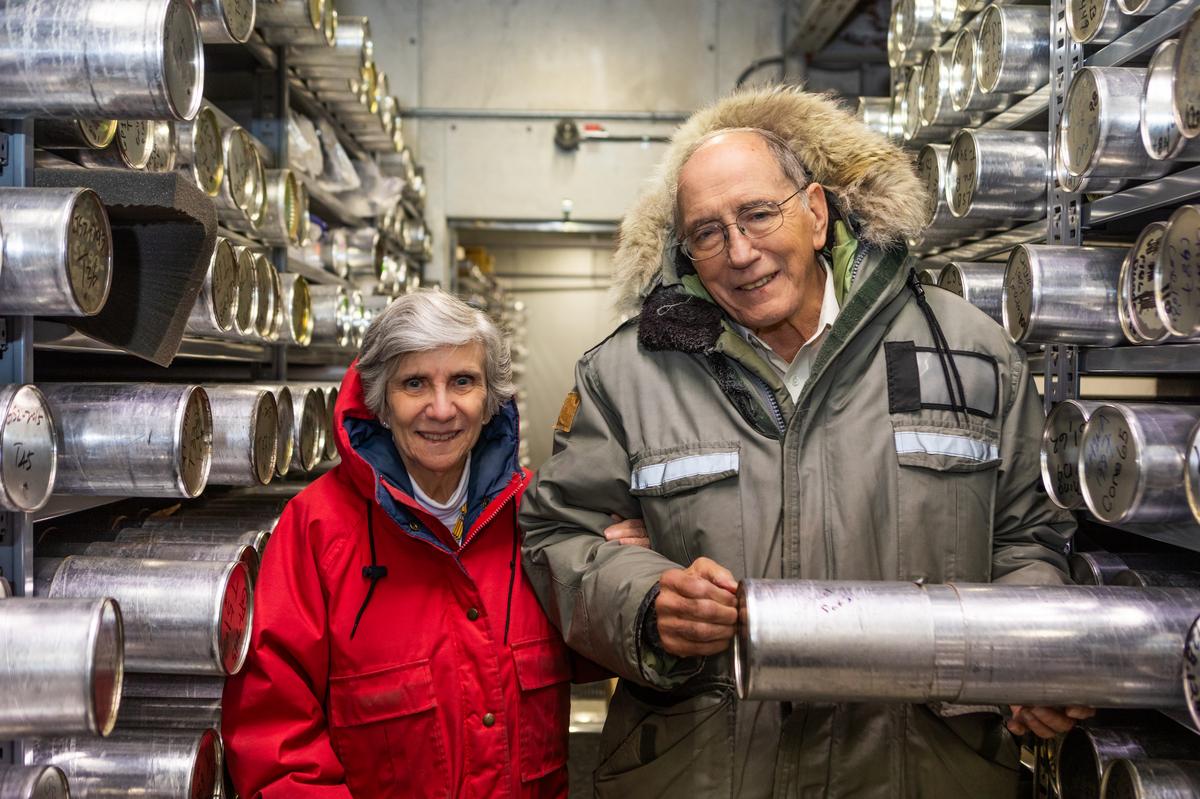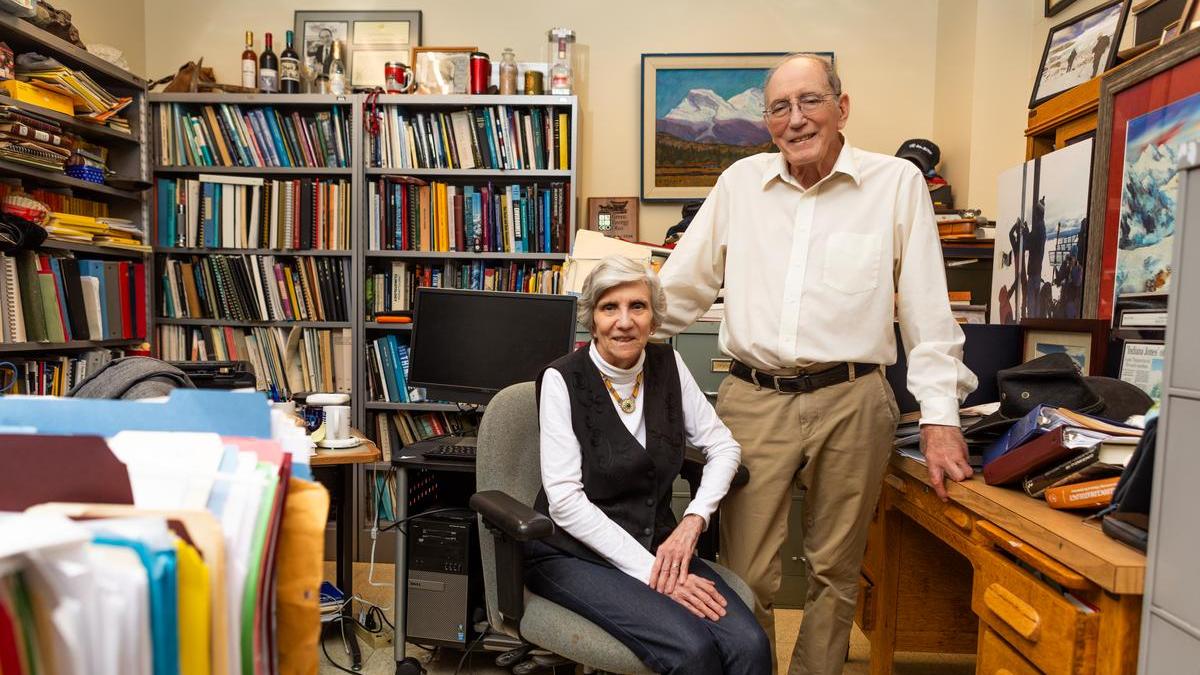World-renowned researchers are on a mission to preserve glacial ice cores for future generations of scientists

Ellen Mosley-Thompson, PhD, and Lonnie Thompson, PhD, at the Byrd Polar and Climate Research Center at The Ohio State University.
Lonnie Thompson, PhD, and Ellen Mosley-Thompson, PhD, have lived extraordinary, adventure-filled lives. As spouses, research partners, and globally recognized paleoclimatologists—scientists who study ancient climates—Lonnie and Ellen have journeyed across continents and hemispheres to retrieve glacial ice cores that help us better understand our Earth’s climate history.
Collectively, their expeditions have taken them to destinations as remote as Antarctica, with bitter subzero temperatures, and as high as Mount Kilimanjaro in Tanzania, a dormant volcano that rises more than 19,000 feet above sea level. Ice cores collected from these sites and others are housed at the Byrd Polar and Climate Research Center at The Ohio State University, where Lonnie and Ellen work as Distinguished University Professors.
Collecting an ice core is no simple task: it requires a well-trained team and a great deal of preparation, heavy equipment, problem solving, and patience—often in remote, harsh environments. But preserved in each ice core is a vivid and unique history that helps scientists better understand the global climate and changes in the environment. Spanning back hundreds of thousands of years, ice cores tell the Earth’s story—a story that, in recent decades, has been increasingly punctuated by the impacts of climate change.
“Ice cores are probably our best recorder of the past on this planet,” Lonnie explained. “They record not just climate—things like temperature and greenhouse gases like carbon dioxide and methane—they capture things like precipitation, volcanic eruptions, microbes, anything that’s in the air at the time. They’re just an amazing recorder of so many variables.”
“ Glaciers tell the truth. They are sending a very loud message to all of us. But the record is disappearing— once these glaciers are gone, they’re gone.”
— LONNIE THOMPSON, PHD
As Ellen put it, she and Lonnie, both from West Virginia, came into the field of glaciology and paleoclimatology serendipitously. The couple met while attending a holiday party at Marshall University, where they each completed their undergraduate studies. When Lonnie started graduate school at Ohio State, he initially planned to study coal geology before discovering what was then called the Institute of Polar Studies. After joining an expedition to Antarctica, Lonnie knew he wanted to dedicate his career to studying ice cores. In the 1970s, Lonnie became the first scientist ever to collect ice cores from tropical mountain glaciers. His story is the focus of a recently released documentary, CANARY, now streaming.
Watch the official trailer for CANARY from Oscilloscope Laboratories HD. Learn more about the film here.
Ellen, who also attended graduate school at Ohio State, started her field work in Antarctica and Greenland, where she has since led more than a dozen expeditions to retrieve ice cores. A highly accomplished researcher, she has authored more than 140 peer-reviewed papers and is an elected member of numerous prestigious scientific organizations, including the National Academy of Sciences and the American Academy of Arts and Sciences.
Together, Lonnie and Ellen have amassed an impressive ice core collection and body of research that have provided substantial evidence of rapidly accelerating climate change. As Lonnie explained, glaciers are the proverbial canary in a coal mine—an early warning system for the planet telling us there’s danger. But as global temperatures rise and glaciers continue to melt, scientists are losing valuable information archived in the ice.
“Glaciers tell the truth,” said Lonnie. “They are sending a very loud message to all of us. But the record is disappearing—once these glaciers are gone, they’re gone.”
Earlier this year, Lonnie and Ellen established the CANARY Ice Core and Education Fund at The Columbus Foundation to raise funds to preserve a unique archive of ice cores so that future generations of scientists can research and extract climatic and environmental histories from the cores. As both Lonnie and Ellen explained, the ice cores contain valuable information and insights that scientists have yet to discover.
“When we started this ice core group many years ago, we made one measurement—that was it. We measured the insoluble dust, the dust that falls out on the glacier,” Ellen said.

Ellen Mosley-Thompson, PhD, and Lonnie Thompson, PhD, at Ohio State’s Byrd Polar and Climate Research Center.
“Now, because of the development of more equipment and asking more complex questions, we measure probably 50 or 60 things, if you add every element. We’re really just beginning to scratch the surface.”
“You can only imagine 20, 30 years from now with new technologies the questions that could be answered that we haven’t even thought to ask,” Lonnie added.
Lonnie and Ellen also plan to use their fund to provide educational opportunities to students who, for instance, are the first in their family to attend college.
“There are so many smart people out there who don’t ever get a chance to contribute their talents to the world,” Ellen explained. “We’re really passionate about trying to open up opportunities for motivated young people.”
Lonnie and Ellen are also dedicated to getting the message out on the devastating effects of climate change in the hopes of inspiring others into action. Although climate change presents many complex challenges, both Lonnie and Ellen remain optimistic about humanity and people’s ability to work together to solve the climate crisis.
“We didn’t leave the stone age because we ran out of stones. We found a better way,” Lonnie said.
The Columbus Foundation Joins National Climate Collaborative
In May, The Columbus Foundation joined a nationwide coalition of more than 40 community foundations to launch the Community Foundation Climate Collaborative. Members of the collaborative share a commitment to support climate action in their respective communities and to address inequities fueled by the climate crisis. For more information, visit www.cfon.org/cfcc.